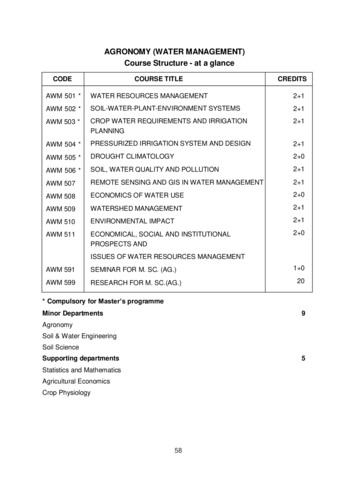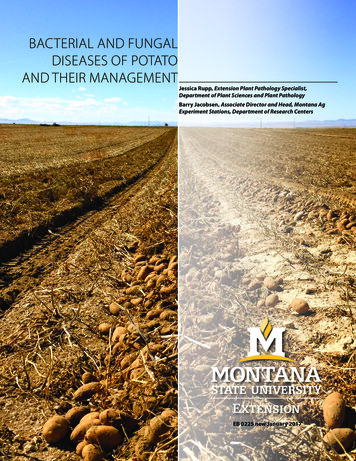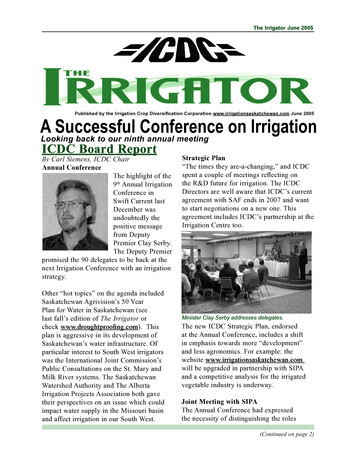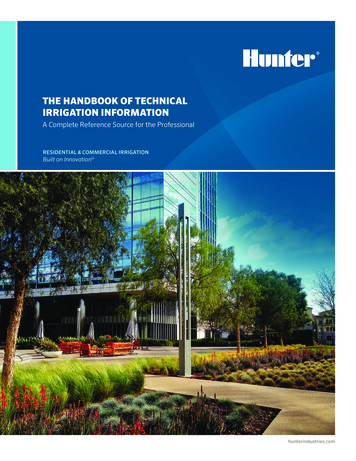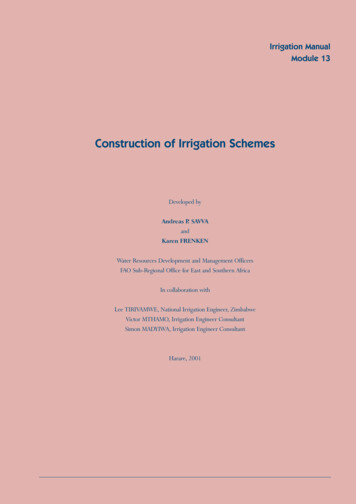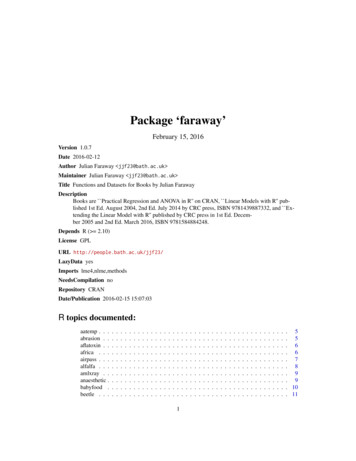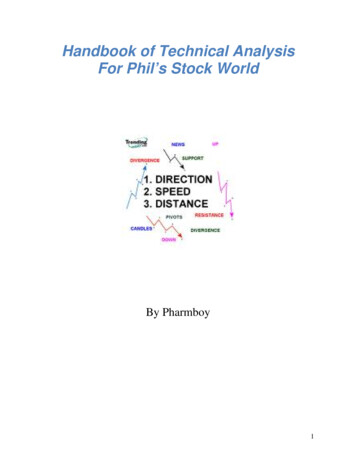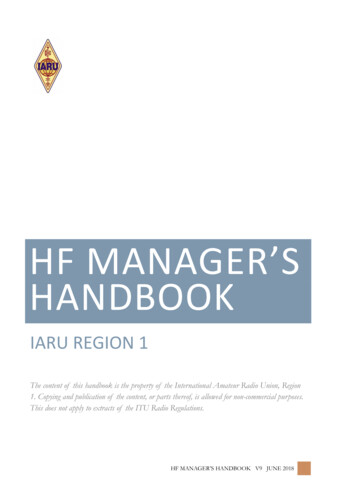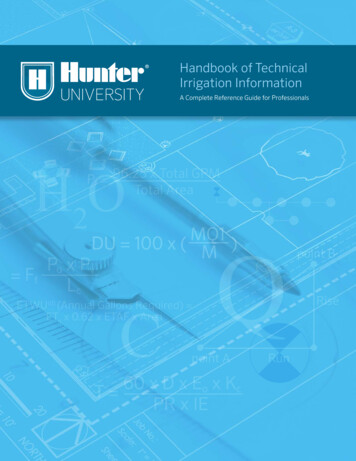
Transcription
UNIVERSITYHandbook of TechnicalIrrigation InformationA Complete Reference Guide for ProfessionalsH2OPr 96.25 x Total GPMTotal AreaQMQ1DU 100 x ( M )Po x Pv FfLcCETWU(d) (Annual Gallons Required) ETo x 0.62 x ETAF x Areapoint AT 60 x D x Eo x KcPR x IERunpoint BRise
PREFACEHunter’s Handbook of Technical Irrigation Information is areference guide for all irrigation professionals. Contractors,architects, designers, and engineers alike can now benefit froma wide spectrum of information that has been gathered fromnumerous sources and compiled into a single document.For more information about irrigation, visithunterindustries.com.
FORMULASTABLE OF CONTENTSFORMULASCONVERSIONS4 Slope34 Variables and Units6 Dynamic Pressure Determination36 Conversion Table7 Friction Factor Pipe Sizing51 Decimal and Metric Equivalents ofCommon Fractions10 Friction Loss in Pipe10 Static Pressure Determination13 AB 1881, California Calculation of MaximumApplied Water Allowance (MAWA)14 AB 1881, California Calculation of EstimatedTotal Water Use (ETWU)16 MWELO Appendices A, B, and C20 Maximum System Capacity Requirement22 Brake Horsepower22 Horsepower Required in Pumping Water23 Net Positive Head Available24 Total Dynamic Head52 Slope Comparison53 Slope Reference Chart: Percent, Angle,and Ratio53 Maximum Precipitation Rates for Slopes54 Using the Water Supply Requirements Table55 Water Supply Requirements56 Friction Factor Shortcuts58 Friction Factor Shortcuts for Class 200 PVC*60 Friction Factor Shortcuts for Class 160 PVC*62 Friction Factor Short Cuts for Polyethylene(PE) – SDR-7 (IPS) Pressure-Rated Tube25 Water Horsepower Requirements64 Approximate Flow Rates in Simple LoopedMain Lines26 Coefficient of Uniformity65 Average Number of Sprinklers per Acre27 Distribution Uniformity66 Screen Filter Mesh Equivalents28 Precipitation Rate67 Approximate Cost of Pump Operation30 How to Calculate Areas31 Drip Calculations68 Table of Pump Horsepower Requirements(WHP) (at 100% Pump Efficiency)32 Scheduling Coefficient69 Basic Electricity and Ohm’s Law32 Irrigation Frequency70 Wire Data: Standard Annealed Copperat 20 C33 Sprinkler Run TimeHUNTER Handbook of Technical Irrigation InformationCONVERSIONS12 Water HammerTABLESTABLES11 Velocity of FlowFRICTION LOSS CHARTS11 Velocity Head71 Table of Voltage Losses for Annealed CopperWire 25 C (77 F) (Loss per 1,000'of Wire)TABLE OF CONTENTS1
FORMULASCONVERSIONS72 Approximate Number of Wiresto be Installed in Conduit or TubingMaximum Number of Wires in Conduit orSleeving95 Polyethylene Plastic Pipe ID Controlled72 Estimating Pipe Size98 HDPE DR 11 160 PSI (IPS Size, OD Controlled)73 Operating Pressures for PVC, PolyethylenePipe and Copper Tube Pressure Rating (PSI)at 73.4 F (23 C)9973 Copper Tube101 C900 DR 18 Class 150 (C.I.O.D.)74 PVC Schedule 40 and Schedule 80 Pipe andInjection Molded Fittings SuggestedMaximum Internal Pressure RatingsPressure Rating (PSI) at 73.4 F (23 C)102 C900 DR 14 Class 200 (C.I.O.D.)75 Affinity Laws105 PVC 63 IPS Plastic Pipe96 HDPE DR 7 265 PSI (IPS Size, OD controlled)97 HDPE DR 9 200 PSI (IPS Size, OD controlled)HDPE DR 13.5 128 PSI (IPS Size, ODControlled)100 C900 DR 25 Class 100 (C.I.O.D.)103 C905 DR 25 165 PSI (C.I.O.D.)104 C905 DR 18 235 PSI (C.I.O.D.)106 PVC 100 IPS Plastic PipeFRICTION LOSS CHARTS76 Irrigation Association Friction Loss andVelocity Charts 200877 Water Meter Pressure Loss Chart78 Pressure Loss Through Water Meters79 Type K Copper Tubing80 Type L Copper Tubing81 Type M Copper Tubing107 PVC 125 IPS Plastic Pipe108 50' Head Plastic Irrigation Pipe (PIP)109 100' Head Plastic Irrigation Pipe (PIP)110 SDR-81 50 PSI Plastic Irrigation Pipe (PIP)111 SDR-51 80 PSI Plastic Irrigation Pipe (PIP)112 SDR-41 100 PSI Plastic Irrigation Pipe (PIP)113 SDR-32.5 125 PSI Plastic Irrigation Pipe (PIP)114 Class 150 Asbestos-CementTABLES82 Schedule 40 Steel83 Schedule 80 Steel84 Cast-Iron Pipe —Class 15086 Class 160 PVC IPS Plastic Pipe88 Class 200 PVC IPS Plastic Pipe90 Class 315 PVC IPS Plastic Pipe91 Schedule 40 PVC IPS Plastic PipeFRICTION LOSS CHARTS93 Schedule 80 PVC IPS Plastic PipeHUNTER Handbook of Technical Irrigation InformationTABLE OF CONTENTS2
FORMULAS116 Portable Aluminum Pipe with Couplings117 Australian Standard PVC PN 6 Plastic Pipe118 Australian Standard PVC PN 9 Plastic Pipe120 Australian Standard PVC PN 12 Plastic Pipe122 Australian Standard PVC PN 15 Plastic Pipe124 Loss of Pressure Due to Friction in OrdinaryRubber Hose125 Roughness Coefficient C Values forHazen-Williams Equation126 Reference Tables for Selected DataCONVERSIONS126 Table of Approximate Pressure Losses forPipe Fittings127 Pressure Loss Through Swing Check Valves127 Pressure Losses Through Copper andBronze Fittings128 Pressure Losses in Valves and FittingsFRICTION LOSS CHARTSTABLES129 NotesHUNTER Handbook of Technical Irrigation InformationTABLE OF CONTENTS3
FORMULASFORMULASGENERALSLOPESlope, as used in irrigation, is a measure of the incline of an area. It can be described as (1) a percent, formula “A,”(2) a degree, formulas “B” and “C,” or (3) a ratio, formula “D.” The greater the incline, the greater the tendencyfor runoff.A. The percent of slope can bedetermined by dividing the netchange in elevation between twopoints (rise) by the horizontaldistance between those twopoints (run).B. The degree of slope describesa slope as the angle of the slope(at “A”) from the horizontal plane.This method is useful whentaking field measurements as “c”represents the measured distanceup a slope and “a” equals theelevation change.RiseS RunPoint Basin A cPoint BRisePoint AcaRunPoint AWhere:S Percent of slopeRise Net elevation changein elevation betweentwo pointsHorizontal PlaneWhere:A AngleRun Horizontal distance betweenthe two pointsa Height of the righttriangleNote: The units for rise and runcan be any unit of linear measure,but they must be the same for boththe rise and run.c Length of the hypotenuse ofa right triangleExample:What is the slope for a bank 40' wide(run) on which the elevation at thetop (point “B”) is 20' higher than thetoe of the slope (point “A”)20S 40S 0.50 or 50%HUNTER Handbook of Technical Irrigation InformationExample:a 20'c 44.72'20sin A 44.72sin A 0.4472A 26 34'FORMULAS GENERAL4
C. The degree of slope describesa slope as the angle of the slope(at “A”) from the horizontal plane.This method is useful whendetermining the slope from plotplans that include elevation. In thisdiagram, “b” represents thehorizontal distance between points“A” and “B” and “a” equals theelevation change between points “A”and “B.”atan A bPoint BD. Describing a slope as a ratio suchas 2:1, 1:1, or 4:1 indicates the numberof feet of run for every 1' of rise. Forinstance, a 2:1 slope indicates therewould be 2' of horizontal distancefor every 1' change of elevation. A1:1 would change 1' of elevation forevery 1' of horizontal run. This can becalculated by dividing the amountof elevation change by the horizontal distance over which this changeoccurred.RiseSr Run : 1Point BRiseaPoint APoint ARunbHorizontal PlaneRise Net elevation changebetween two pointsWhere:A Anglea Height of the right triangleb Horizontal distanceExample:a 20.0'b 40.0'Run Horizontal distance betweenthe two pointsNote: The units for rise and runcan be any unit of linear measure, butthey must be the same for both therise and run.Example:A slope on a project is 20' high (rise)over a distance of 40' (run). What isthe slope ratio?20.0tan A 40.0tan A 0.4472Where:Sr Slope ratioA 26 34'40Sr 20 : 1Sr 2 : 1Note: See pages 52 and 53 formore information on slopes.HUNTER Handbook of Technical Irrigation InformationFORMULAS GENERAL5FORMULASSLOPE (continued)
HYDRAULICSDYNAMIC PRESSURE DETERMINATIONFORMULASDynamic pressure is the pressure when water is flowing in the system. Dynamic pressure in a system can bedetermined by flow tests, pressure gauges, or calculation if information on pipe types and sizes, valves, meters,or other relevant components is known. The dynamic pressure can be calculated at a given point in the system bystarting with a known dynamic pressure at a given point, adjusting for elevation change, and subtracting frictionlosses in pipe, fittings, valves, meters, etc., as shown below:Dynamic Pressure PSI dynamic ! h e elevationh - h f pipe - h f fittings - h f valvesWhere:PSIdynamic Known dynamic pressure at a given point in PSIhe elevation Pressure change due to elevation in PSIhf pipe PSI loss due to friction losses in the pipehf fittings PSI loss due to friction losses in fittingshf valves PSI loss due to friction losses in valves, meters, or other relevant components between the sourceand the given point in the systemControl Valve PointB100' Point AELEVATION VIEWWater MeterExample:In the diagram above, the dynamic pressure at point “A” is 90 PSI. The pipe is 2" class 315 PVC, 200' from point“A” to point “B” with a flow rate of 40 GPM. According to the manufacturer, the control valve will lose 1.0 PSI at 40GPM.90.00PSI at point “A”- 43.30PSI loss due to elevation gain (100 ft. x 0.433 PSI per foot)46.70PSI at point “B”2.82PSI friction loss in pipe (1.41 PSI loss per 100' x 200' / 100)43.88Subtotal0.28PSI friction loss in fittings (estimate, 10% of friction loss in pipe)43.60Subtotal1.00PSI loss in valve (from manufacturer data)42.60PSI dynamic pressure at point “B”HUNTER Handbook of Technical Irrigation InformationFORMULAS HYDRAULICS6
Friction Factor is used to determine the maximumflow in gallons per minute through any section oflateral line pipe below a predetermined pressurevariation. To minimize uneven distribution, sprinklersshould operate with pressure variation betweensprinklers of not more than 10 to 20% of thedesired sprinkler operating pressure.P #PFf 0 L vcWhere:Ff Friction Factor, the allowable pressure lossper 100' of pipe, in PSIPo Sprinkler operating pressure in PSIP v Pressure Variation allowed between thevalve and the last sprinkler on the circuitbeing sized, usually 10% or 20% of thedesired sprinkler operating pressureLc Critical Length of pipe from control valveto farthest head in hundreds of feetFORMULASFRICTION FACTOR PIPE SIZINGExample:A) You must determine the amount of pressurevariation you can allow between the valve and thelast sprinkler head. This is usually 10% to 20% of theoperating pressure of the sprinklers on that particularsection. For this example we will use 10% (0.10)variation.If a control valve operates a group of sprinklers thatrequire 30 PSI to operate (operating pressure Po), the10% pressure variation (pressure variation P v) wouldallow a total variation of 3.0 PSI from the valve to thefarthest head (0.10 x 30 PSI 3.0 PSI).B) Determine the Critical Length (Lc)Next, you must determine the distance the watertravels from the control valve to the farthest head. Thatdistance is not necessarily the total length of pipe in thesection, but simply the length of the pipe through whichthe water flows from the valve to the farthest head.Divide this number by 100 to determine the hundreds offeet from the valve to the farthest head.This is called Critical Length and represents thehundreds of feet of pipe in which you can afford to losethe pressure you determined was acceptable forpressure variation in step “A.”Figure 1In this diagram, you must determine the path the waterflows from the valve to the farthest head and calculatethat distance in feet. The water flow path is shown inFigure 2 and is represented by the pipe with the checkpattern. Note that the distance of the branch line isnot included. This is because the water flowing to thefarthest head does not travel down that length of pipe,and therefore any pressure loss occurring in the branchdoes not affect the pressure in the Critical Length. Control Valve for these sprinklers Sprinkler head requiring 30 PSI and delivering2.0 GPM at that pressure20'40'80'HUNTER Handbook of Technical Irrigation Information40'60'FORMULAS HYDRAULICS7
FRICTION FACTOR PIPE SIZING (continued)FORMULAS Farthest head20'180'Figure 2In Figure 2, the water traveling from the valve to thefarthest head must pass through 200' of pipe. Thisdivided by 100 gives a Critical Length (Lc) in hundreds offeet of 2.0.C) Determine the rate at which you can lose pressure inthe pipe. This is called Friction Factor (Ff), which is theallowable PSI loss per 100' of pipe. You can determinethis allowable rate of loss by dividing the allowablepressure loss (in PSI) by Critical Length (in hundreds offeet) by using the formula below.The sprinklers mentioned in Figure 1 require 30 PSIto operate and a distance of 200' from the valve tothe farthest head. Using the formula below we candetermine the Friction Factor.Ff Po # PvL c /100lFf 30 # 0.10200/1003Ff 2The Friction Factor indicates that the pipe should besized so that no section of pipe exceeds a pressure lossof 1.5 PSI per 100'. This ensures that over the 200' fromthe valve to the farthest head, the total PSI losswill not exceed the 3.0 PSI allowable loss (10% of thesprinkler operating pressure). The Friction Factor canbe used like a budget. It provides a guideline by whichyou can size the pipe without having excessive pressureloss in any section.For the lateral pipes (those downstream of the controlvalve), use Class 315 PVC for 1/2" pipe and Class 200PVC for all larger sizes. Although this requirement forClass 315 and Class 200 is not mandatory and may varyon many larger installations, it is typical for landscapeprojects ranging from residential through mediumsized commercial projects in the Southern and WesternUnited States.At this point, turn to the Friction Factor Shortcuts chartsin the Tables section on page 58. Find the chart forthe Friction Factor closest to the one calculated for yoursprinkler system section. (In this case there is a chartfor a Friction Factor of 1.5 PSI allowable loss per100'. When there is no chart for the exact Friction Factorcalculated, round the Friction Factor tothe nearest chart value.)Ff 1.5 allowable PSI loss per 100 ft of pipeHUNTER Handbook of Technical Irrigation InformationFORMULAS HYDRAULICS8
Figure 3 represents a portion of the Friction FactorShortcut chart from page 58. The chart in the appendixshould look like Figure 3 shown below.Friction Factor½" CL 315 PVC1.50 Max. GPM2.8¾" CL 200 PVC5.71" CL 200 PVC10.81¼" CL 200 PVC19.91½" CL 200 PVC28.52" CL 200 PVC51.12½" CL 200 PVC84.33" CL 200 PVC141.4Figure 3FORMULASFRICTION FACTOR PIPE SIZING (continued)The “Max. GPM” listed in the chart represent themaximum GPM that each pipe type/size can sustainwithout exceeding a loss of 1.5 PSI per 100′.Using the maximum flow rates in the chart as guides,the lateral line pipes can be sized with the assurancethat the total PSI loss from the control valve to thefarthest sprinkler will not exceed 10% of the sprinkleroperating pressure (3.0 PSI).First, determine the quantity of water in GPM passingthrough each section of pipe. A given section may needto be sized differently if there is any change in the GPM,so it is important to determine the flows carefully. Figure4 lists the GPM flowing through each section of pipe.Notice the section labeled 10 GPM. This value is the flowto all sprinkler heads beyond that point and includesboth the straight run and the branch line.14121064242Figure 4Using the chart (Figure 3) as a guide, assign sizes toeach pipe section.1¼"1¼"1"1"¾"½"¾"½"Figure 5Note that in the section with 6 GPM, we used 1" pipe.The chart allows up to 5.7 GPM in ¾" pipe and somedesigners may choose to use ¾" instead of 1". It isacceptable to use ¾" pipe, even though it exceeds theallowable loss (the Friction Factor), because pressure isconserved in some sections where the flow is below themaximum allowed.HUNTER Handbook of Technical Irrigation InformationFORMULAS HYDRAULICS9
FORMULASFRICTION LOSS IN PIPESTATIC PRESSURE DETERMINATIONThe Hazen-Williams equation can be expressedas follows and is the most commonly used formulafor calculating pressure loss in PVC pipe.Static pressure is the measure of pressure when the wateris at rest. This pressure is determined by the weight of acolumn of water resting on one square inch and expressed asthe pounds per square inch (PSI). The weight of a column ofwater 1' high will create 0.433 pounds of pressure over everysquare inch. Static pressure can be determined as follows:1.852100 1.852 Qh f 0.00090914 a C k4.866 LdWhere:hf Head loss due to friction in poundsper square inch (PSI)Ps A ! 0.433 HC Hazen-Williams coefficient for roughnessof the inside of the pipeWhere:Ps Static pressure at a given point in the system,in pounds per square inch (PSI)Q Flow in gallons per minute (GPM)A Static pressure at starting point in PSId Inside diameter of pipe in inchesL 0.433 A constant representing the weight of water ina column 1' high as expressed in poundsper square inchLength of pipe in feetExample:A 2" class 200 PVC pipe (I.D. 2.129") that is 500′in length will deliver 50 GPM to an irrigation system.Compute the friction loss in the pipeline.100 1.852 50 1.852 lh f 0.00090194 a 150 k b5002.129 500h f 7.544 PSIH Net vertical change in elevation from thesurface of the water to the given point in thesystem in feet, increase in elevation, uphill,results in PSI loss (–0.433) downhill results PSIgain ( 0.433)Control Valve40'(12 m)Water MeterELEVATION VIEW Point A60 PSI (414 kPa)(Static pressure)HUNTER Handbook of Technical Irrigation InformationFORMULAS HYDRAULICS10
Example:Determine static pressure at the entrance to thecontrol valve if the static pressure at the meteris 60 PSI. (Note: If change in elevation is downhill,the elevation change (H) would be a positive).Ps 60 - 0.433 # 40hPs 42.68 PSIVELOCITY HEADFORMULASSTATIC PRESSUREDETERMINATION (continued)The velocity head is the pressure required tomove the water through the system.H v V 2 /2gWhere:Hv Velocity head, the energy required to movethe water at the intended velocity, in feetV Water velocity, in feet per secondFor static pressure in metric units, use:Ps A - 9.79 HPs 414 - 9.79 # 12hPs 296.52 kPaWhere:Ps Static pressure at a given point in thesystem in kilopascals (kPa)A Static pressure at the starting pointin kPa9.79 A constant representing the weight ofwater in a column one meter high asexpressed in kPaH The net vertical change in elevation fromthe surface of the water to the givenpoint in the system in metersg Acceleration due to gravity (32.2)Example:What is the Velocity Head required to move40 GPM through a 2" Class 315 PVC pipe?H v 4.15h /64.4H v 0.27 feet2VELOCITY OF FLOWVelocity of flow is a calculation of the speed of watermoving in a closed pipe system.V 0.408Qd2Where:V Flow velocity in feet per second (fps)Q Flow in gallons per minute (GPM)d Inside diameter of pipe in inches0.408 Constant used to convert units into feetper secondExample: What is the velocity of flow for a 1" class 200 PVC pipe(1.169" I.D.) with a flow rate of 10 GPM?V 0.408 c10 m 1.169h2V 2.99 fpsHUNTER Handbook of Technical Irrigation InformationFORMULAS HYDRAULICS11
WATER HAMMERFORMULASThis formula is used to estimate the total surgepressure developed when there is a sudden reductionor cessation in the velocity of flow. This is typical when acontrol valve closes.Pt Po aV # L # 0.07 ktWhere:P t Total pressure developed, in PSIPo Operating pressure at the time of valveclosing, in PSIV Velocity at the time the reduction in velocityoccurred, in feet per secondL Length of straight pipe between source andpoint where reduction in velocity occurred, thiswould be the longest section, in feet (straightpipe means no tee or ell fittings)t Seconds during which the velocity was reduced,for example, a valve that closes in a half secondwould have a value for “t” of 0.5Example:An electric remote control valve has a hydraulic closuretime of 0.8 seconds. The main line leading to the valve is450' long with a velocity of 4.2 fps. The system is operating at 65 PSI at the time of valve closure. What is thetotal surge pressure?Pt 65 a4.2 # 450 # 0.07 k0. 8132.3Pt 65 0.8Pt 230.38 PSI0.07 Constant used to convert velocity, length, andtime into pressureHUNTER Handbook of Technical Irrigation InformationFORMULAS HYDRAULICS12
Maximum Applied Water Allowance (MAWA) is usedto determine the amount of water a project is allowedto use for landscape purposes. This determines the limitfor projected water use. Projects must be designed withan Estimated Total Water Use (ETWU) that is less thanthe limit allowed in the MAWA calculation. The use ofthis formula is mandated by California State AssemblyBill 1881 (the Water Conservation in Landscaping Actof 2006).MAWA (e) (Annual Gallons Allowed) (ETo) (0.62) [(ETAF # LA) ((1 - ETAF) # SLA)]Where:MAWA Maximum Applied Water Allowance(gallons per year)ETo0.62 Reference Evapotranspiration(inches per year) Conversion Factor (to gallons)ETF (for WAWA only) ET Adjustment Factor (ETAF)LASLA ETAF (Schools) 0.65 ETAF (Residential) 0.55MAWA (51.1 in) (0.62) [(0.55 # 50, 000) ((1 - 0.55) # 0)] 871, 255 gallons per year or 1, 165 hundred cubic feetTo convert from gallons per year to hundred-cubic-feetper year:1, 108, 870 1, 482 hundred-cubic- feet per year748(100 cubic- feet 784 gallons) (2) In the next hypothetical example, the landscapeproject in Fresno, California, has the same ETo value of51.1" and a total landscape area of 50,000 ft2. Within the50,000 ft2 project, there is now a 2,000 ft2 area plantedwith edible plants. This 2,000 ft2 area is then consideredto be a Special Landscape Area.MAWA (51.1 in) (0.62) [(0.55 # 50, 000) ((1 - 0.55) # 2, 000)] 31.682 # [27, 500 900] 31.682 # 28, 400 899, 769 gallons per year or 1, 203 hundred cubic feetFor complete information about the California ModelWater Efficient Landscape Ordinance, visit the California ETAF (Non-residential) 0.45Department of Water Resources website at: Landscape Area Including SLA (square feet) ncy/Urban-Water-Use-Efficiency/Model-Water Special Landscape Area (square feet)Efficient-Landscape-OrdinanceExample:(1) A hypothetical landscape project in Fresno, California,with an irrigated landscape area of 50,000 ft2 withoutany Special Landscape Area (SLA 0, no edible plants,recreational areas, or use of recycled water). To calculateMAWA, the annual reference evapotranspiration valuefor Fresno is 51.1".HUNTER Handbook of Technical Irrigation InformationFORMULAS INDUSTRY MANDATES13FORMULASINDUSTRY MANDATESAB 1881, CALIFORNIA CALCULATION OF MAXIMUM APPLIEDWATER ALLOWANCE (MAWA)
AB 1881, CALIFORNIA CALCULATION OF ESTIMATEDTOTAL WATER USE (ETWU)FORMULASThis formula is used to calculate the estimatedamount of water used in a landscape. The ETWUmust be less than the Maximum Applied WaterAllowance (MAWA), as shown in the previous formula,in order to receive project approval. The use of thisformula is mandated by California State AssemblyBill 1881.Where:ETWU Estimated Total Water Use per year (gallons)ETo Reference Evapotranspiration (inches)LA Landscape Area (square feet)0.62 Conversion FactorETAF PF/IE PF Plant Factor IE Irrigation Efficiency Overhead Irrigation 0.75 Drip Irrigation 0.81Example:Determine the ETWU of an irrigated landscape area of 50,000 ft2 without any Special Landscape Areas (SLA 0, noedible plants, recreational areas, or use of recycled water). The ETo value is 51.1" annually, and the plant water usetype, plant factor, and hydrozone area are shown in the table belowHydrozoneSprinklerTypePlant WaterUse Type(s)IrrigationEfficiencyPlant Factor(PF)*Hydrozone Area(HA) (square feet)1OverheadHigh.750.87,000236,559 (317)2OverheadHigh.750.710,000295,699 (369)3DripMedium.810.516,000312,908 (419)4DripLow.810.37,00082,138 (110)5DripLow.810.210,00078,228 (105)ETWU SumETWU Gallons PerYear (HCF Per Year)1,005,532 (1,345)*Plant Factor from WUCOLSETWU 51.1h 0.62hb24, 700 0 l0.71 1, 102, 176 gallons per yearCompare ETWU with MAWA: For this example, MAWA (51.1in)(0.62)[(0.55 x 50,000) ((1 - 0.55) x 2,000)] 871,255 gallons per year. The ETWU (1,005,532 gallonsper year) is more than MAWA (871,255 gallons per year).In this example, the water budget does not comply withthe MAWA.HUNTER Handbook of Technical Irrigation InformationETWU Per HydrozoneHZ 1 (51.1)(0.62)(0.8 / 0.75)(7,000)HZ 1 236,559 gallons per year or 317 hundredcubic feet per yearHZ 2 (51.1)(0.62)(0.7 / 0 .75)(10,000)HZ 2 295,699 gallons per year or 369 hundredcubic feet per yearHZ 3 (51.1)(0.62)(0.5 / 0.81)(16,000)HZ 3 312,908 gallons per year or 419 hundredcubic feet per yearHZ 4 (51.1)(0.62)(0.3 / 0.81)(7,000)HZ 4 82,138 gallons per year or 110 hundred cubicfeet per yearHZ 5 (51.1)(0.62)(0.2 / 0.81)(10,000)HZ 5 78,228 gallons per year or 105 hundred cubicfeet per yearAverage ETAF 0.63Sum of all hydrozones 1,005,532 gallons per year or1,345 hundred cubic feet per yearFORMULAS INDUSTRY MANDATES14
Using example 2 from page 13, determine the ETWU of an irrigated landscape area of 50,000 ft2 with 2,000 ft2of edible plants (Special Landscape Area). The ETo value is 51.1" annually, and the plant water use type, plant factor,and hydrozone area are shown in the table below.HydrozonePlant Water UseType(s)Plant Factor (PF)*Hydrozone Area(HA) (square feet)PF x HA(square 23,5002,0002,0006SLA1.0*Plant Factor from WUCOLS23, 500ETWU 51.1h 0.62hb 0.71 2, 000 l 31.68h 33, 099 2, 000h 1, 111, 993 gallons per yearCompare ETWU with MAWA. For this example:MAWA 51.1h 0.62h6 0.7 # 50, 000h 0.3 # 2, 000h@ 31.68 # 635, 000 600@ 31.68 35, 600 1, 127, 808 gallons per yearThe ETWU (1,111,993 gallons per year) is less than MAWA (1,127,808 gallons per year). In this example, the waterbudget complies with the MAWA.For complete information about the California Model Water Efficient Landscape Ordinance, visit the CaliforniaDepartment of Water Resources website cient-Landscape-OrdinanceFor Appendix A - Reference Evapotranspiration (ETo) Table, please de.For the most up-to-date ET data in your region, visit https://cimis.water.ca.gov/HUNTER Handbook of Technical Irrigation InformationFORMULAS INDUSTRY MANDATES15FORMULASAB 1881, CALIFORNIA CALCULATION OF ESTIMATEDTOTAL WATER USE (ETWU) (continued)
APPENDIX A. SAMPLE WATER EFFICIENT LANDSCAPEWORKSHEETFORMULAS0.55 ForHUNTER Handbook of Technical Irrigation InformationMWELO16
APPENDIX B. SAMPLE CERTIFICATE OF COMPLETIONFORMULASAppendix C – Sample Certificate of Completion.CERTIFICATE OF COMPLETIONThis certificate is filled out by the project applicant upon completion of the landscape project.DatePART 1. PROJECT INFORMATION SHEETProject NameName of Project ApplicantTelephone No.Fax No.TitleEmail AddressCompanyStreet AddressCityStateProject Address and Location:Zip CodeStreet AddressParcel, tract or lot number, if available.CityLatitude/Longitude (optional)StateZip CodeProperty Owner or his/her designee:NameTelephone No.Fax No.TitleEmail AddressCompanyStreet AddressCityStateZip CodeProperty Owner“I/we certify that I/we have received copies of all the documents within the Landscape DocumentationPackage and the Certificate of Completion and that it is our responsibility to see that the project ismaintained in accordance with the Landscape and Irrigation Maintenance Schedule.”Property Owner SignatureDatePlease answer the questions below:1. Date the Landscape Documentation Package was submitted to the local agency2. Date the Landscape Documentation Package was approved by the local agency3. Date that a copy of the Water Efficient Landscape Worksheet (including the Water BudgetCalculation) was submitted to the local water purveyorHUNTER Handbook of Technical Irrigation InformationMWELO17
APPENDIX B. SAMPLE CERTIFICATE OF COMPLETION (continued)FORMULASPART 2. CERTIFICATION OF INSTALLATION ACCORDING TO THE LANDSCAPEDOCUMENTATION PACKAGE“I/we certify that based upon periodic site observations, the work has been completed in accordance withthe ordinance and that the landscape planting and irrigation installation conform with the criteria andspecifications of the approved Landscape Documentation Package.”Signature*DateName (print)Telephone No.Fax No.TitleEmail AddressLicense No. or Certification No.CompanyStreet AddressCityStateZip Code*Signer of the landscape design plan, signer of the irrigation plan, or a licensed landscape contractor.PART 3. IRRIGATION SCHEDULINGAttach parameters for setting the irrigation schedule on controller per ordinance Section 492.10.PART 4. SCHEDULE OF LANDSCAPE AND IRRIGATION MAINTENANCEAttach schedule of Landscape and Irrigation Maintenance per ordinance Section 492.11.PART 5. LANDSCAPE IRRIGATION AUDIT REPORTAttach Landscape Irrigation Audit Report per ordinance Section 492.12.PART 6. SOIL MANAGEMENT REPORTAttach soil analysis report, if not previously submitted with the Landscape Documentation Package perordinance Section 492.6.Attach documentation verifying implementation of recommendations from soil analysis report perordinance Section 492.6.HUNTER Handbook of Technical Irrigation InformationMWELO18
FORMULASAPPENDIX C. PRESCRIPTIVE COMPLIANCE OPTIONHUNTER Handbook of Technical Irrigation InformationMWELO19
MAXIMUM SYSTEM CAPACITY REQUIREMENTFORMULASThe following formula
HUNTER Handbook of Technical Irrigation Information TABLE OF CONTENTS 2 FORMULAS CONVERSIONS TABLES FRICTION LOSS CHARTS 72 Approximate Number of Wires to be Installed in Conduit or Tubing Maximum Number of Wires in Conduit or Sleeving 72 Estimating Pipe Size 73 Operating Pressures for PVC, Poly
